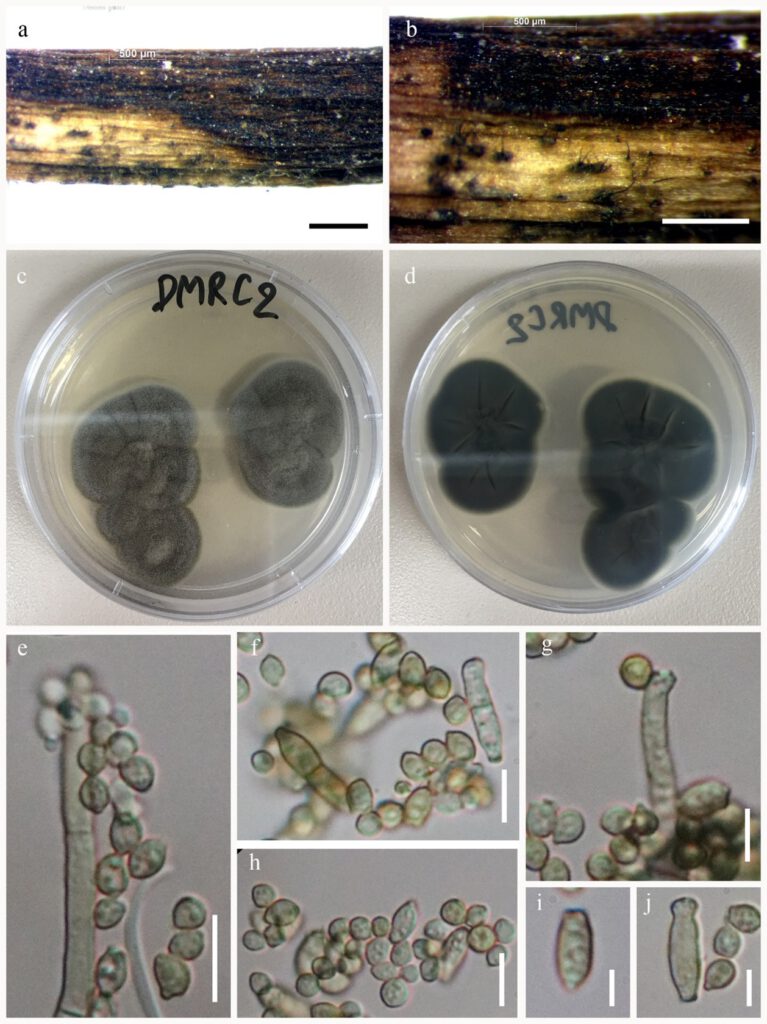Cladosporium dracaenae Chaiwan, Tibpromma & K.D. Hyde, sp. nov (DMRC2) (Fai)
MycoBank number: MB; Index Fungorum number: IF; Facesoffungi number: FoF 10749;
Holotype – MFLU 18–****
Etymology – Referring to the host genus on which the fungus was collected, Dracaena (Asparagaceae).
Saprobic on dead leaves of Dracaena fragrans. Sexual morph: Undetermined. Asexual morph: Mycelium superficial and immersed, composed of septate, branched, 2.5–5 μm wide, subhyaline to pale brown, smooth to slightly roughened, thin-walled hyphae. Conidiophores erect, straight, cylindrical, non-nodulose, septate, simple or branched, up to 130 μm long, 2.5–4 μm wide, pale brown, smooth or sparingly verrucose with darkened and refractive scars. Conidiogenous cells terminal or intercalary, cylindrical, geniculate, 7–36 × 2–4 μm, with up to five apical loci of 1.5–2 μm diam, thickened and refractive. Ramoconidia aseptate, subcylindrical to cylindrical, 11–36 × 2–3 μm, pale brown, smooth-walled. Conidia forming branched chains with up to three conidia in the terminal unbranched part, pale brown, sparingly verrucose, with protuberant, somewhat darkened and refractive conidial hila; small terminal conidia aseptate, oval, 5–6.5 × 2–3.5 μm (av. (± SD) 5.9 (± 0.4) × 2.8 (± 0.4)); intercalary conidia aseptate, ellipsoidal to almost cylindrical with attenuated ends, 7–13 × 2.5–3 μm (av. (± SD) 10.6 (± 2.5) × 2.6 (± 0.2)); secondary ramoconidia 0–1-septate, ellipsoidal, 8.5–18 × 2–3 μm (av. (± SD) 14.3 (± 3.3) × 2.6 (± 0.5)).
Material examined – THAILAND, Chiang Mai Province, Mea Tang District, on dead leaves of Dracaena fragrans, 17 Febuary 2019, Napalai Chaiwan, DMRC2, MFLU 1***–***, living culture MFLUCC 12–****.
Host – On dead leaves of Dracaena fragrans (This study).
Distribution – Thailand (This study).
GenBank accession numbers – ITS: OM912043. TEF: ***, ACT: ***
Notes – The morphology of this collection is similar to Cla. alboflavescens and Cla. anthropophilum (Cla. cladosporioides complex) (Sandoval-Denis1 et al. 2016). It possesses pale-colored vegetative structure but it differs in forming shorter conidial chains with Cla. alboflavescens up to 3 conidia in the terminal unbranched part and often showing substrate intercalary conidia, while conidial chains of the novel species are much shorter and intercalary conidia ellipsoidal to cylindrical being also genetically well differentiated. The phylogenetic analyses of our new species close to Cla. anthropophilum isolate from human bronchoalveolar lavage fluid. This may be due to the difference in the substrate. Thus we identified the new species as Cla. dracaenae that report from Dracaena fragrans in Thailand. A comparison of the ITS nucleotides of these new species reveals 45/552 (0.081%) nucleotide differences and the TEF nucleotides of these new species reveals 124/876 (0.141%) nucleotide differences, ACT nucleotides of these new species reveals 30/199 (0.150%) nucleotide differences from Cladosporium anthropophilum (KUMCC19-0202) which indicates that they are distinct taxa (Jeewon & Hyde 2016).

Figure *** Cladosporium dracaenae (DMRC2, MFLU ***, herbarium). a, b Appearance of fungi on host substrate. c–d Culture from PDA. e–j Conidia and ramoconidia Scale bars: a–b =500 μm. e = 15 μm. , f–h=10 μm. i–j=5 μm.
